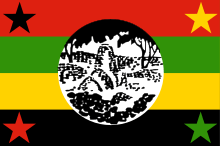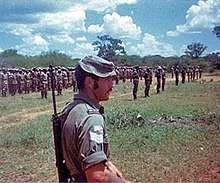Zimbabwe People's Revolutionary Army
Zimbabwe People's Revolutionary Army (ZIPRA) was the armed wing of the Zimbabwe African People's Union, a Marxist–Leninist political party in Rhodesia. It participated in the Rhodesian Bush War against the Rhodesian government. ZIPRA was formed during the 1960s by the nationalist leader Jason Moyo, the deputy of Joshua Nkomo.
| Zimbabwe People's Revolutionary Army | |
|---|---|
 Flag of ZAPU | |
| Active | 1964–1980 |
| Country | Zimbabwe |
| Type | Guerrilla |
| Size | 20,000 personnel in 1979 |
| Part of | Zimbabwe African People's Union |
| Commanders | |
| Notable commanders | Alfred Nikita Mangena Lookout Masuku |
Operations
Because ZAPU's political strategy relied more heavily on negotiations than armed force, ZIPRA developed as elaborately training both regular soldiers and guerrilla fighters, although by 1979 it had an estimated 20,000 combatants,[1] based in camps around Lusaka, Zambia and at the front. ZIPRA's crossing points into Zimbabwe were at Feira in Zambia opposite Mashonaland East and West. For example, the operational boundary was Sipolilo where ZIPRA, Zimbabwe African National Liberation Army (ZANLA) and Rhodesian forces clashed. ZIPRA operated alone in Mashonaland West. There was no ZANLA combatants in that area until the later stages of the war.[2]
Beside the overall political ideologies, the main differences between ZIPRA and ZANLA were that:
- ZIPRA did not follow ZANLA's ideology (inspired by Maoism) but followed Soviet Marxist Leninist principles.
- ZIPRA controlled zones from Sipolilo to Plumtree.
ZIPRA was in formal alliance with Umkhonto we Sizwe (MK), the ANC's militant wing. ZIPRA and MK mounted a celebrated, if strategically unsuccessful, raid into Rhodesia in the mid-1960s. The incursion was stopped by Rhodesian Security Forces, working in concert with the South African Police.
In 1978 and 1979 ZIPRA downed two civilian passenger planes of Air Rhodesia, killing a total of 102 passengers and crew. Air Rhodesia Flight 825 was a scheduled flight from Kariba to Salisbury that was shot down on 3 September 1978 by ZIPRA guerrillas using an SA-7 surface-to-air missile. ZIPRA leader Joshua Nkomo publicly claimed responsibility for shooting down the Hunyani on BBC television the same evening, saying the aircraft had been used for military purposes, but denied that his men had killed survivors on the ground. Eighteen of the fifty-six passengers in the Air Rhodesia plane survived the crash, with most of these having been seated in the rear. Three crash survivors who remained at the aircraft managed to avoid being killed by running away and hiding in the bush. Five months later a second plane, Air Rhodesia Flight 827, was shot down by ZIPRA.
ZIPRA commanders and soldiers

- Dumiso Dabengwa, head of intelligence and member of the ZIPRA high command[3]
- John Dube, commander at the Wankie battle[3]
- Tshinga Dube, head of signals and member of the ZIPRA high command[3]
- Alfred Nikita Mangena, first commander of ZIPRA[4]
- Robson Manyika, member of the ZIPRA high command[3]
- Lookout Masuku, commanded ZIPRA after the death of Jason Moyo[5]
- Report Mphoko, chief of logistics and member of the ZIPRA high command[3]
- Ambrose Mutinhiri, commander at Morogoro[3]
- Ackim Ndlovu, member of the ZIPRA high command[3]
- Roy Reagen Ndlovu
- Joseph Nyandoro, member of the ZIPRA high command[3]
- Philip Valerio Sibanda[6]
- Eddie Sigoge[7]
- Cephas Cele, member of the zipra high command was chief of staff and training
References
- Lohman, Major Charles M.; MacPherson, Major Robert I. (7 June 1983). "Rhodesia: Tactical Victory, Strategic Defeat" (pdf). War since 1945 Seminar and Symposium. Quantico, Virginia: Marine Corps Command and Staff College. Retrieved 19 October 2011.CS1 maint: ref=harv (link)
- Martin, D & Johnson, P. (1981). The Struggle for Zimbabwe. Faber & Faber. p. 400.
- "Up close with Col. Tshinga Dube". Sunday Mail. 8 September 2012. Retrieved 17 May 2013.
- Kriger, Norma J (2003). Guerrilla Veterans in Post-war Zimbabwe: Symbolic and Violent Politics, 1980–1987. Cambridge University Press. p. 316.
- "Lookout Masuku dies at 46; commanded Nkomo forces". The New York Times. 7 April 1986. Retrieved 17 May 2013.
- "The Zimbabwe National Amy". Retrieved 29 February 2012.
- "Nkomo's security chief tells police he shot farmer's brother". Zim Eye. 14 May 2009. Retrieved 17 May 2013.
Further reading
- Rasmussen, R. K., & Rubert, S. C., 1990. A Historical Dictionary of Zimbabwe, Scarecrow Press, Inc., Metuchen, N.J., United States of America.
- Sunday mail, Sunday, 8 October 2006, Zimbabwe's true armed struggle history must be told
.jpg)